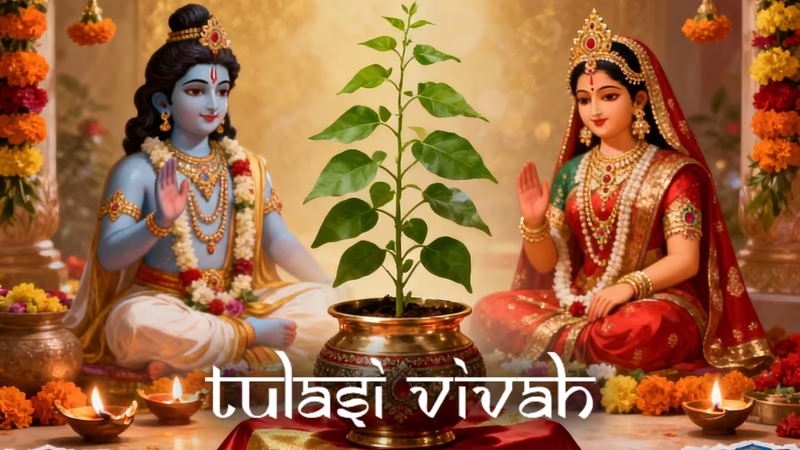Can you feel that? That amazing, cozy, festive buzz from Diwali is still hanging in the air. Even as the last diyas get packed away, that feeling of joy isn't going anywhere. In fact, it's making way for something so heartfelt and beautiful.
The happy times are so not over!
We’re getting ready for what is honestly the most special and divine wedding of the entire year... we’re talking about Tulasi Vivah!
Yep, mark your calendars! This year, on Sunday, November 2, 2025, homes everywhere will be buzzing with the sweetest preparations for this sacred union.
This day is just overflowing with meaning. It’s so much more than just a ceremony; it’s a pure celebration of love, devotion, and all the wonderful, auspicious new beginnings that are on their way.
So, whether you're planning to perform the puja at home or just want to soak in all the special vibes, you’ve come to the right place.
Tulasi Vivah 2025: Puja Timings & Shubh Muhurat
Let's talk about the times first! The holy month of Kartik has a sunny fortnight, and the Tulasi Vivah puja takes place on the Dwadashi Tithi, which is the 12th day.
This year, the tithi is particularly good because it falls on the same day.
- The date of the Tulasi Vivah is Sunday, November 2, 2025.
- The start of Dwadashi Tithi is at 7:31 AM on November 2, 2025.
- The end of Dwadashi Tithi is at 5:07 AM on November 3, 2025.
What is the best time (Shubh Muhurat) for the puja?
The period of evening twilight, called Godhuli Muhurat, is seen to be the best and most magical moment to have a vivah (wedding).
The best time for Godhuli is between 5:35 PM and 6:01 PM.
This is the lovely, golden hour when day turns into night. It's the perfect time for a heavenly wedding!
There is also a very good time to do the puja during the day:
Abhijit Muhurat, or the auspicious muhurat, is from 11:42 AM to 12:26 PM.
So, you have a lot of great choices!
What makes Tulasi Vivah so important?
So, what's the big deal about this one wedding? What makes it so special to us?
Well, the meaning of Tulasi Vivah is extremely profound and beautiful.
It's the Divine Green Flag for Weddings
This is the most important one! The Hindu wedding season officially starts with Tulasi Vivah.
It is like the universe's "green light," signaling the end of Chaturmas, which is the four-month period when good things are put on hold. People believe that this holy marriage blesses all the weddings that come after it.
Learn all about the traditions, puja timings, and importance of Gopashtami 2025 in this detailed guide.
A Blessing for a Happy Marriage
This is a celebration of the holy marriage between the Tulsi plant (which stands for Goddess Lakshmi) and Lord Vishnu (in his Shaligram form).
People say that married couples who celebrate this day will have a long, happy, and peaceful marriage. People who are not married believe that doing this pooja with a pure heart can provide you with a great life mate.
For families without a daughter, performing Tulasi Vivah and offering Tulsi to Lord Vishnu is considered as meritorious as Kanyadaan, the sacred ceremony of giving one's daughter in marriage.
It is a lovely, genuine act that is said to provide a lot of punya (merit).
Respecting Nature and Devotion
This celebration is a beautiful reminder of how connected we are to nature. We aren't just praying to a plant; we're honouring the goddess that lives inside it.
It honours Tulsi's unwavering commitment and purity, and it's a lovely way to bring the benefits of health, tranquillity, and wealth into our homes.
Explore the sacred rituals, timings, and spiritual importance of Skanda Shashti Vrat 2025 in this complete guide.
Lovely Tale of Tulasi Vivah
There is a reason for every ceremony, and the story behind Tulasi Vivah is an epic tale of love, devotion, and a curse.
There was a woman named Vrinda who loved Lord Vishnu very much. She was wedded to Jalandhar, a great demon king.
Vrinda was so loyal to her husband (a pativrata) and so pure that her piety made an unbreakable shield around Jalandhar.
He got so strong that he fought the devas (gods), and even Lord Shiva couldn't beat him. The universe's balance was in danger.
The gods asked Lord Vishnu for help. Lord Vishnu understood that the only way to beat Jalandhar was to breach Vrinda's vow of virginity.
He then changed into Jalandhar and went to see Vrinda. She broke her pledge since she thought he was her spouse. When her purity was lost, Jalandhar's protective barrier went away, and Lord Shiva was able to beat him in combat.
Vrinda was heartbroken when she found out what had transpired. She was so sad and angry that she cursed Lord Vishnu, claiming that he would one day be separated from his bride (which happens in his avatar as Lord Rama). She also told him that he would turn into a stone.
People pray to Lord Vishnu because he is the holy black Shaligram stone.
Lord Vishnu was very impressed by her genuine devotion. He blessed Vrinda and gave her a wish that she would be reborn as the holy Tulsi plant.
He also pledged that he would always be with her by marrying her in his Shaligram form every year.
So, every year on this day, we remember that promise from God. We celebrate Tulasi Vivah, the eternal and holy wedding of Goddess Tulsi and Lord Shaligram. This reminds us that real devotion is always, always blessed.
I hope this event makes the celebration even better for you as you get your Tulsi plant ready and cook the prasad.
I hope that Tulasi Vivah offers you and your family a lot of happiness and good fortune!
Now that you know the significance of Tulasi Vivah, take your devotion a step further. Buy digital gold in Jar and start something truly auspicious today.










